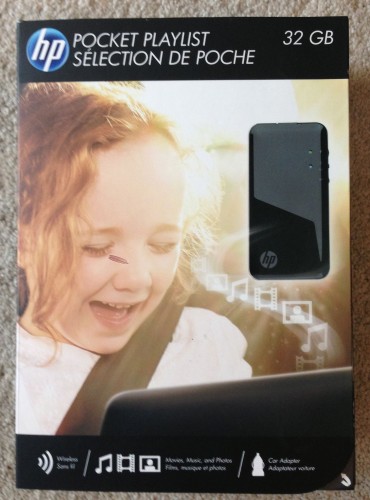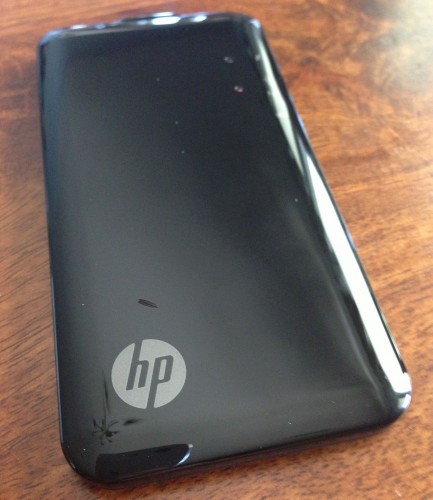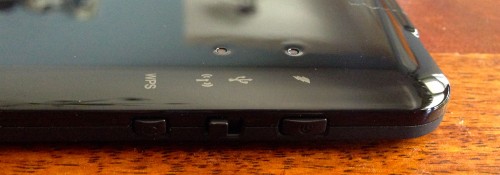With each passing year, flash storage is cheaper and more plentiful, but the options for using storage have become fewer. Apple has few options for storage expansion, and fewer Ultrabooks, tablets and smartphones allow expansion. But the HP Pocket Playlist offers 32GB of wireless storage for use even when you are offline, and does it in a stylish $99 package.
Description:
•Engineered to entertain: Hey, parents! The HP Pocket Playlist puts you in control of managing your mobile entertainment. No matter where you go— car, train, restaurant, mall— your kids sit still, not fight and stay happy watching their own favorite videos.
•Small enough to stow: Slim. Trim. Fits in the palm of your hand. The HP Pocket Playlist is the first thing you’ll pack each time. This premium entertainment device is smaller and lighter than your average smartphone, so it easily fits everywhere you go.
•Compatible to the highest degree[2]: The accomplished HP Pocket Playlist works with all different brands, makes & models. Easily stream content to your iPad®, iPod® touch & iPhone®. It works like a dream with Windows®-based PCs, Android® phones & tablets and Kindle™ Fire.
•32GB of storage power. What does that equal? 16 full-length movies[1], 7,600 songs or 10,000 photos.[3] That’s massive amount of entertainment.
•Got USB port? Then, you can charge it or load it from your PC. USB compatibility works with any Windows®-based PC.
•No cords to fight with or trip over. Far-reaching 30ft (10m) wireless range gives you the freedom to move around (802.11b/g/n).
•3 buttons control it all. Obvious on/off button. Easily switch between USB & wireless. Instantly activate secure connection (WPS).
•Compatible with HP Slate 7, HP Elitepad, iPad®, iPod® touch & iPhone; Windows®-based PCs, Android® phones & tablets and Kindle™ Fire. (Requires iOS 4.3 and above; Windows® XP/Vista™/7/8; Android® 2.2 and above, Kindle™ Fire and above.)
Overview and Impressions:
The use case for the HP Pocket Playlist seems rather narrow in many ways – it is smaller and lighter than most portable hard drives – but also has much lower capacity; offers decent storage for a flash drive, but is larger and more expensive; and it offers wireless storage connectivity, but … well, there really is no downside to that.
In terms of the device itself, it is an attractive package that reminds me of the WebOS powered HP TouchPad in a couple of ways: it is sleek minimal, but it is also a horrible fingerprint magnet! The outside edges contain the micro-USB connection, a lanyard loop, the power and WPS buttons, and the WiFi/USB switch.
Using the Pocket Playlist is simple – power it up by holding the button for a few seconds, connect to your PC using the USB cable to fill up your storage with music, photos, movies or files. The software is PC-only and needed to get things set up properly by configuring the name and
The presence of a physical switch for USB to WiFi seems odd, like having to switch between USB and FireWire on an external hard drive. It seems that the device should auto-switch, but at the same time it works to save battery – which might have been the intent.
Once configured, you download the app for your iOS or Android device (or Kindle Fire) and use the WiFi settings to connect to your Pocket Playlist. Then open the app and you will be able to browse through your media and play music or movies. I was able to immediately put this to use with my kids, allowing them to stream to an iPad and iPod Touch while we were driving. By creating a private wireless network, the Pocket Playlist serves as a content streaming server while for up to 5 devices in local range.
One immediate concern was that connecting to the Pocket Playlist required disconnecting from other WiFi networks. For something like the iPad or iPod Touch on a trip that wasn’t a big deal, but when trying to use it when at home it was a problem. I looked at the ‘quick start’ manual and documentation, and there was no mention of dealing with this. So I looked online and found a few possible solutions, basically putting the Pocket Playlist in ‘hotspot mode’.
The FAQ on the Pocket Playlist site was laughably frustrating – because it contained circular references. One document would send you to a different document for help, and that document would send you back to the original. I eventually found a reference on HP’s site that helped me configure hotspot mode, but I still found it finicky and unreliable.
So what good is a wireless flash storage device that requires fiddling to work wirelessly with internet connected devices?
I let that question answer itself for me – I loaded it up with a bunch of music and a couple of movies so that there was something for everyone in my family, got it set up for everyone to use with their phones … and left it sitting in our ‘tech bin’ along with external battery chargers and so on. Everyone was clear that they could grab it to use whenever they wanted.
But no one did. Not across two weeks and a few drives of more than a half-hour. When I asked ‘why’, I was told it was too much of a hassle to get the hotspot mode working reliably. Sometimes it would work fine, other times it would require them to only connect to the Pocket Playlist; they decided that the hassle wasn’t worth it.
And after having to reset everything to get hotspot mode working again on my Samsung Galaxy SIII for the second time, I came to the same conclusion. Now the Pocket Playlist has been repurposed as just another external file storage drive that I hook up to my laptops using a USB cable; it works great in that role.
Review: Hewlett-Packard Pocket Playlist
Where to Buy: HP.com
Price: $129 (though even on HP.com it discounts to $99)
What I Like: Great looks; solid general performance; offers hotspot mode; simple to set up basic WiFi connection
What Needs Improvement: Fingerprint magnet; expensive for capacity; flaky hotspot mode; dubious utility overall
Source: Manufacturer provided review unit
Here is my hands-on look:




